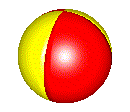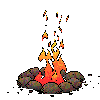|
Here are some traditional games for you to play. Some require you to make the equipment.
Have fun!!!!!!
Tossed Ball:
Toss a large inflated ball into the air in the midst of a group. Players must try to keep
the ball in motion up in the air without letting it fall or touch the ground. Traditionally, this game was played
with an inflated animal bladder. A lightweight ball, such as a beach ball will do.
Ball Juggling: 
Each player keeps from two to four balls (often three) in the air by tossing from hand
to hand. Clay or stone balls are used traditionally, roughly 1-2 inches in diameter. Small, round stones from a
riverbed work well. Other lightweight rubber balls may be substituted.
Foot Races:
 Foot Races are
traditionally done at the end of the day after all chores have been finished. Divide the children into groups by
age or size and mark off courses of appropriate length for each level. Lay out long- and short-distance races for
each group. Players race from the starting point over to and around a tree, rock or other natural turning point
and back again. Foot Races are
traditionally done at the end of the day after all chores have been finished. Divide the children into groups by
age or size and mark off courses of appropriate length for each level. Lay out long- and short-distance races for
each group. Players race from the starting point over to and around a tree, rock or other natural turning point
and back again.
Cat's Cradle:
 This game is
found among cultures throughout Native America. The Zuni and Dine peoples of the Southwest say that cat's cradle
was taught to human beings by the Spider people, powerful and wise figures in many of their stories. This game is
found among cultures throughout Native America. The Zuni and Dine peoples of the Southwest say that cat's cradle
was taught to human beings by the Spider people, powerful and wise figures in many of their stories.
Cat's cradle is played by using the hands (lips and teeth are allowed, too) to manipulate
string into a variety of intricate patterns. It is nearly impossible to write directions on how to play cat's cradle
without filling pages with detailed steps. The best way is to learn how to play from someone who knows and share
that knowledge with the children. There is an endless variety of forms that can be created, some of which are shown
in our printout below.
Tops:
 Tops are traditionally
made from wood, bone, stone or clay. They may be plain or painted with designs. Some tops have holes drilled in
the sides so that they whistle as they spin. Whip tops
are spun off a cord made of sinew or bark that's attached to a long pole. The top is whipped as it spins to keep
it going. Peg tops are about 4 inches tall. There are
many different designs, all of which involve spinning the top spindle between the thumb and index finger. (see
printout). Tops are traditionally
made from wood, bone, stone or clay. They may be plain or painted with designs. Some tops have holes drilled in
the sides so that they whistle as they spin. Whip tops
are spun off a cord made of sinew or bark that's attached to a long pole. The top is whipped as it spins to keep
it going. Peg tops are about 4 inches tall. There are
many different designs, all of which involve spinning the top spindle between the thumb and index finger. (see
printout).
For simplicity and safety, we recommend that the children use peg tops to play these games:
- Sit in a circle and have someone spin their top, then quickly run around the outside
of the circle and try to get back to their place before the top stops spinning.
- Spin the tops and see whose top spins the longest.
- Try to keep the top spinning within a marked circle so that it does not cross the edge.
Ring and Pin:
Make a ring out of a piece of bark, a thick piece of leather, a thin flexible twig bent
and tied into the shape of a circle, or some other suitable material (see printout figure C). Depending on how
difficult the game is to be, the ring diameter should be between 1.25 inches to 5 inches: the wider, the easier.
Use any strong, flexible cord to attach the ring to the stick toward one end. Hold onto the short end of the stick
with the ring dangling from the cord. Swing the ring up and forward and try to thrust the far end of the stick
through the hole in the ring. One point is usually awarded for each successful catch of the ring, on the stick.
Different designs can be made to make the game more interesting for older children. For instance, when playing
with the design using two connected rings, two points are earned for catching the ring by the outer hole and four
points for catching it through the inner hole.
Buzz:
This game is better for older children. Make the buzz from a round section of a branch
about 2 inches thick with two holes drilled about 1/2 inch apart from each other. For balance, each hole must be
exactly the same distance from the center. In order to be certain that no pieces will fly off the buzz as it spins,
make sure that the bark is removed from the wood and the wood is not cracked. Thread the cord or string as shown
in the printout (figure D). Slip your fingers through each end of the loop and spin the buzz around hard until
the cord has wound up tight. Quickly pull outward on both ends at once and the buzz will spin around. Keep the
buzz going by alternately pulling (each time the cord winds up tight) and relaxing (each time the cord has unwound
and begins to unwind). As you relax your hold, bring your hands together a little to allow room for the string
to contract as it winds up tight again. With practice, you can keep the buzz turning indefinitely by pulling and
relaxing your pull in synchrony with the rhythm of the buzz. The buzz makes a distinct whizzing or "buzzing"
sound as it spins.
Print out directions for these games
Toys
|
 Games are
far more than a time of play in Native American cultures. They symbolize the chase, the harvest and other fertility
events in nature, important ceremonies, events in the agricultural cycle, war remembrances and preparations and
the discovery of probable outcomes of human efforts.
Games are
far more than a time of play in Native American cultures. They symbolize the chase, the harvest and other fertility
events in nature, important ceremonies, events in the agricultural cycle, war remembrances and preparations and
the discovery of probable outcomes of human efforts. Games and
other activities are some of the many ways that traditional Native Americans enjoy and celebrate the magical time
of campfires. Flames leap and dance along with the excitement of the circle of people throughout the evening. Games
are played, dances danced, stories told. Finally the fire dies down and so does the energy level. Eyelids grow
heavy with sleep. It is said that if the stories have been strong and the time shared in other ways around the
fire enjoyable, children will have good thoughts as they slide into the land of dreams.
Games and
other activities are some of the many ways that traditional Native Americans enjoy and celebrate the magical time
of campfires. Flames leap and dance along with the excitement of the circle of people throughout the evening. Games
are played, dances danced, stories told. Finally the fire dies down and so does the energy level. Eyelids grow
heavy with sleep. It is said that if the stories have been strong and the time shared in other ways around the
fire enjoyable, children will have good thoughts as they slide into the land of dreams.

 Foot Races are
traditionally done at the end of the day after all chores have been finished. Divide the children into groups by
age or size and mark off courses of appropriate length for each level. Lay out long- and short-distance races for
each group. Players race from the starting point over to and around a tree, rock or other natural turning point
and back again.
Foot Races are
traditionally done at the end of the day after all chores have been finished. Divide the children into groups by
age or size and mark off courses of appropriate length for each level. Lay out long- and short-distance races for
each group. Players race from the starting point over to and around a tree, rock or other natural turning point
and back again. This game is
found among cultures throughout Native America. The Zuni and Dine peoples of the Southwest say that cat's cradle
was taught to human beings by the Spider people, powerful and wise figures in many of their stories.
This game is
found among cultures throughout Native America. The Zuni and Dine peoples of the Southwest say that cat's cradle
was taught to human beings by the Spider people, powerful and wise figures in many of their stories. Tops are traditionally
made from wood, bone, stone or clay. They may be plain or painted with designs. Some tops have holes drilled in
the sides so that they whistle as they spin. Whip tops
are spun off a cord made of sinew or bark that's attached to a long pole. The top is whipped as it spins to keep
it going. Peg tops are about 4 inches tall. There are
many different designs, all of which involve spinning the top spindle between the thumb and index finger. (see
printout).
Tops are traditionally
made from wood, bone, stone or clay. They may be plain or painted with designs. Some tops have holes drilled in
the sides so that they whistle as they spin. Whip tops
are spun off a cord made of sinew or bark that's attached to a long pole. The top is whipped as it spins to keep
it going. Peg tops are about 4 inches tall. There are
many different designs, all of which involve spinning the top spindle between the thumb and index finger. (see
printout).